What's New 
Top Recent Cameras
October 28
Review posted for Nikon L120!
Sporting a 25-525mm equivalent lens and relatively big grip to go with it, the Nikon L120 looks like it could be a good bargain in the long zoom digital camera category. Its 14.1-megapixel CCD sensor can capture stills or 720p HD video, and is capable of capturing up to 14.6 frames per second at a reduced resolution of 3 megapixels, and its high-res LCD displays captured photos beautifully. Despite a good set of special features, the Nikon L120 is more about making picture taking easy, as its many fail-safe modes attest. Click here for more on the budget Nikon L120.
October 26
Printer Review:  Canon Pixma Pro-1!
Canon Pixma Pro-1!
Canon shipped a Pro-1 to us early and we've been putting it through its paces all week. Arriving in a black plastic shroud, the Canon Pro-1 printer weighed in at 71 lbs. We managed to get it on a table, strip the orange tape away, load the ink tanks and drop in the print head. Software installation was routine, although we note Mac OX 10.7 Lion is not yet supported with the appropriate driver (let alone the application software). The application software matters with the Pro-1 because it can print CD/DVDs -- if you have the software. This is also Canon's first printer with a full set of gray inks for monochrome printing. And we can confirm Canon's claim that the "out of the box" experience was a pleasure. Color, grayscale, CDs all printed flawless immediately. We have some 29 images plus four sets of screen shots illustrating various features of the Pro-1 set for our review. And we're just getting started!
October 25
Extender Comparison:  Canon's EF Extenders!
Canon's EF Extenders!
Over on SLRgear.com we've spent the past few weeks reviewing Canon's lineup of EF Extenders. We've produced a summary article which discusses the effects of teleconverters, and then does a side-by-side comparison of the version II and III 1.4x and 2x Extenders. Click here to read that article!
October 20
First test shots posted for Nikon V1!
We've just posted our first set of test shots from a production-level Nikon V1, straight from the lab! Compared to the more consumer-oriented J1, the Nikon V1 has the higher specification, with a built-in electronic viewfinder, a better LCD panel, a mechanical shutter, stereo microphone jack, magnesium alloy body, and an accessory port that accepts either a proprietary flash strobe, or a GPS unit. The Nikon V1 and J1 share the same CX-format image sensor that has an effective resolution of 10.1 megapixels, and a diagonal of approximately 15.9mm. That's quite a lot larger than the 7.7mm chip used in Pentax's Q, but significantly smaller than 21.6mm Micro Four Thirds and ~28mm APS-C sensors. Nikon couples its new CX-format imager with a new EXPEED 3 image processing engine featuring dual imaging pipelines. Click here for more on the Nikon V1, and visit the Nikon V1 Samples page for the images we've shot so far, including links to select RAW files. Stay tuned for more lab images in the days to come!
October 19
Review posted for Samsung Galaxy S II smartphone camera!
With an 8-megapixel digital camera, the Samsung Galaxy S II makes an interesting choice if you're looking for a phone that can double as a daily-carry digital camera. The Galaxy S II has a pretty good quality 30mm equivalent lens, and a set of options that rivals a dedicated pocket camera when it comes to exposure, white balance, scene settings, and even capturing panoramic images. Video quality isn't bad either, able to capture up to Full HD video. Click here for our Samsung Galaxy S II Camera review!
October 18
Canon EOS-1D X previewed!
Canon USA Inc. has today unveiled a new flagship professional SLR that, in one stroke, replaces both the 1Ds Mark III and 1D Mark IV: the Canon EOS-1D X. The Canon 1D X includes changes aplenty since the earlier cameras, and looks to offer a pretty impressive feature set overall. Key among its features are a new 18-megapixel full frame CMOS image sensor and dual DIGIC 5+ image processors that together allow 12 fps burst shooting, and ISO sensitivities to a maximum of 204,800 equivalents. There's also a new 61-point autofocus system, and a new RGB metering sensor with approximately 100,000 pixel resolution, with a DIGIC 4 image processor dedicated specifically to autofocus and metering operation. Other features of particular interest include Full HD video capture, a new AF tracking and recognition system, in-camera lens aberration and distortion corrections, in-camera multiple exposure capability, a 14 fps high speed burst mode (with locked mirror, capped ISO and in JPEG only), dual CompactFlash storage slots, in-camera gigabit Ethernet connectivity, and a whole lot else besides. Click here for more on the new Canon 1D X professional digital SLR.
October 17
Lens Review: 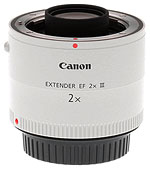 Canon 2x Extender EF III!
Canon 2x Extender EF III!
Over on SLRgear.com we conclude our look at Canon's Extender series of teleconverters, with a full review of the 2x Extender EF III. Released at the end of last year, the III series changed the optical configuration, as well as adding autofocus improvements and weather sealing. Did it improve the effect on image quality, too? Find out by reading our full review of the Canon 2x Extender EF III.
October 13
First test shots posted for Sony NEX-7!
We've just posted our first set of test shots from a production-level Sony NEX-7, straight from the lab! The Sony Alpha NEX-7 is impressive, not only offering a whopping 24.3 megapixel sensor resolution from an Exmor APS HD CMOS image sensor, but then somehow managing to include enough power to handle shooting at up to 10 frames per second. The NEX-7's sensor also adds an electronic first-curtain exposure mechanism that allows an astoundingly short prefocus shutter lag of just 0.02 second. The NEX-7's impressive speed--enabled by a new generation BIONZ image processor--isn't limited to just still-image shooting, either. It also offers progressive-scan Full HD video at 60 frames per second, from 60fps sensor data. For an in-depth look at Sony's new flagship NEX-series compact system camera, click here to read our Sony NEX-7 Hands-on Preview, and visit our Sony NEX-7 Samples page for the test shots we've taken so far. Check back soon for more Sony NEX-7 lab shots over the next few days.
October 10
Lens Review: 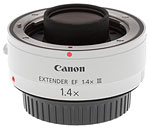 Canon 1.4x Extender EF III!
Canon 1.4x Extender EF III!
Over on SLRgear.com we continue our look at Canon's Extender series of teleconverters, with a full review of the 1.4x Extender EF III. Released at the end of last year, the III series changed the optical configuration but not the overall size and weight. Did it improve the effect on image quality, too? Find out by reading our full review of the Canon 1.4x Extender EF III.
October 6
Review posted for Pentax WG-1 GPS!
If you're looking for a digital camera that captures not just the shots of your last adventure, but also the coordinates of each shot, the Pentax WG-1 has what it takes. And it'll withstand most of the rigors of adventure, including water, dust, cold, and shock; even the crushing pressure found in a backpack or back pocket. What we wanted to know was whether the image quality looked as good as the camera and its specs. Click here to find out in our Pentax WG-1 GPS review!
Lens Review: 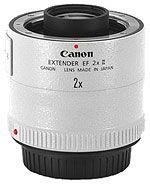 Canon 2x Extender EF II!
Canon 2x Extender EF II!
We reviewed the 1.4x Extender EF II on Monday, and we're following that up today with our review of the 2x Extender EF II. The 2x Extender has been around since 2001, and has already been superceded by version III, but you can still purchase the version II. Click here to read our full review of the Canon 2x Extender EF II.
October 3
Lens Review: 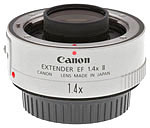 Canon 1.4x Extender EF II!
Canon 1.4x Extender EF II!
At SLRgear.com we get this question a lot: what effect does a teleconverter have on image quality? We've wanted to run this test for a while now, and thanks to our friends at LensRentals.com, we have tested the Canon 1.4x Extender EF II on the 200mm f/2.8L II USM. Over the next few weeks we'll also be rolling out tests of the 2.0x Extender EF II, as well as the version III Extenders. For today however, click here to read our full review of the Canon 1.4x EF II Extender.
September 29
First Shots posted for Pentax Q!
We've just posted our first set of test shots from a production-level Pentax Q, straight from the lab! The heart of the Pentax Q digital camera is a backside-illuminated 1/2.3"-type CMOS image sensor that's quite a bit smaller than Nikon's new CX-format sensor, and much smaller than the Micro Four Thirds and APS-C sized sensors in most other competing models, but which has also allowed Pentax to make the camera body and lenses significantly smaller than those from its competition. Other features of the Pentax Q include in-body image stabilization, piezoelectric dust reduction, five frames-per-second burst shooting, a 3.0-inch LCD panel, and both a built-in popup flash and hot shoe for external strobes. In addition, the Pentax Q can record high-def 1080p movies at 30 frames per second, with H.264 AVC compression. Click here for our hands-on Pentax Q preview, and visit the Pentax Q Samples page for the images we've shot so far, including links to select RAW files. Stay tuned for more lab images in the days to come!
September 25
Lens Review:  Canon 200mm f/2.8L II USM!
Canon 200mm f/2.8L II USM!
Today's lens review over at SLRgear.com is the Canon 200mm f/2.8L II USM. Originally released in 1996, the lens still holds great appeal as a capable telephoto prime lens. We've put the lens through its paces in our lab: click here to read our full review of the Canon 200mm f/2.8L II USM lens.
September 24
Full Review posted for Canon T3!
In the last weeks of 2008, we reviewed Canon's Rebel XS SLR, a camera we felt to be a pretty well-rounded, despite a few quirks that led enthusiasts to look beyond the entry-level pricetag. Still available on closeout, the Rebel XS is now showing its age, and so the Canon T3 replaces that camera. As the new entry-level point to the company's SLR lineup, the T3 is an interesting design, gifting significant upgrades in some areas, and paring back features in others. Based around a newer 12-megapixel image sensor and DIGIC 4 image processor, the Canon T3 most notably increases the upper sensitivity limit to ISO 6,400 equivalent, and adds high-def video capture. It also adds two more focus points, and switches to Canon's clever dual-layer iFCL metering chip, which takes account of color information when determining exposures. Canon has also slightly increased the LCD display size, updated the kit lens to improve the stabilization system, and cut the pricetag by another $100 below that of its predecessor at launch. What had to give, to achieve this? The Canon T3's new optical viewfinder has both lower magnification and a significantly tighter dioptric correction. Burst shooting speed and depth is also towards the lower end of what's available, especially when shooting in RAW or RAW+JPEG modes. In addition, Canon has removed the mechanical portion of its EOS Integrated Cleaning System. To find out whether these tradeoffs were worthwhile given the Rebel T3's aggressive pricing, you'll want to read our Canon T3 review.
September 22
First test shots posted for Nikon J1!
We've just posted our first set of lab test shots from a production-level Nikon J1! The J1's CX-format image sensor has an effective resolution of 10.1 megapixels, and a diagonal of approximately 15.9mm. That's quite a lot larger than the 7.7mm chip used in Pentax's Q, but significantly smaller than 21.6mm Micro Four Thirds and ~28mm APS-C sensors. Nikon couples its new CX-format imager with a new EXPEED 3 image processing engine featuring dual imaging pipelines. The standard ISO-equivalent sensitivity range for the Nikon J1 is ISO 100 to 3,200, and a Hi-1 position allows this to be extended to a maximum of ISO 6,400. Click here for more on the Nikon J1, and visit the Nikon J1 Samples page for the images we've shot so far, including links to select RAW files. Stay tuned for more lab images in the days to come!
September 21
Nikon J1 Galleries posted!
While the Nikon V1 and Nikon J1 news was sprung on us rather late, we were on Manhattan, and it was night time in Times Square, so Shawn went out for a very late shoot in the city. Click here for the Gallery images. Shawn lugged along a tripod to grab some ISO series, which cramped his freedom a bit when he wasn't using it. You'll see two ISO series shots. Lighting changes rather wildly in Times Square because of all the lighted signs, so the ISO series shots aren't made in even light. We were pretty impressed with the results. Our image processor makes these images look fairly bad at the 800 pixel size, so make sure to click all the way through to see the full-size file. Most of the non-series shots were made without a tripod.
Update: We've added some daylight gallery shots, as well as a sample night video!
Nikon V1 and J1 Previewed!
Nikon Inc. has today announced two new compact system camera models, kickstarting its new 1 System series of mirrorless cameras. The Nikon V1 has the higher specification of the pair and includes a built-in electronic viewfinder, while the Nikon J1 aims for a trimmer, more compact design and an even more affordable pricetag. Both cameras share a new CX-format image sensor with an effective resolution of 10.1 megapixels. The sensor has a 2.7x focal length crop, which equates to a diagonal of approximately 15.9mm. That's quite a lot larger than the chip used in Pentax's Q, but significantly smaller than Micro Four Thirds and APS-C models. The Nikon J1 and V1 both feature a dual-core EXPEED 3 processor, which is said to have been optimized for noise performance, speed, as well as battery life. Burst shooting is possible at a full 10 fps with autofocus enabled, and a whopping 60 fps if the focus is locked from the first frame. The speed of the autofocus system comes thanks to the fact that, unlike competing mirrorless cameras which rely solely on contrast detection to determine focus, the Nikon V1 and J1 both have a hybrid autofocus system that combines both phase-detection and contrast-detection modes. The Nikon V1 and J1 can record video at up to 1,920 x 1,080 pixel resolution, with a rate of either 30p, or 60i, from 60 fps sensor output. There's a whole lot more to these exciting new compact system cameras, so read our Nikon V1 and J1 previews for all the details!
September 20
Review posted for Olympus SZ-30MR!
Light and easy to maneuver, the Olympus SZ-30MR is one of the more uniquely handsome digital cameras to come out in some time, with a good grip and a 24x zoom lens. Starting quite wide at 25mm equivalent, the back-pocketable design zooms in to 600mm equivalent. Its 16-megapixel CMOS sensor isn't the only high-resolution device on the SZ-30MR, because its 3-inch LCD sports 460,000 dots. Click here to see what we thought of the Olympus SZ-30MR!
Special Report:  Adobe Elements 10!
Adobe Elements 10!
Everything from your smart phone to your dSLR takes both stills and movies these days. And, really, the video looks pretty good -- especially on an HDTV. But where's the software that is as video smart as it is photo smart? And vice versa? On the tenth anniversary of the launch of Photoshop Elements, Adobe is betting Photoshop/Premier Elements version 10 is just that ticket. So we gave it a run for its money, trying out the new features with our own images and video. See our report for the full story.
September 19
First test shots posted for Olympus E-PM1!
We've just posted our first set of test shots for the Olympus E-PM1, straight from the lab! The Olympus PEN E-PM1 features the same 12.3 megapixel image sensor, TruePic VI image processor, and high-speed "Frequency Acceleration Sensor Technology" autofocus system as in the P3 and PL3 models. The standout feature of the Olympus E-PM1 is its focus on trimming size and weight to a bare minimum, making it the smallest and lightest Olympus PEN available. Read our Olympus E-PM1 preview for more, and visit the Olympus E-PM1 Samples page for the images we've shot so far, including links to select RAW files. Stay tuned for more sample images in the days to come!
Lens Review: 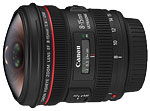 Canon EF 8-15mm f/4L USM Fisheye!
Canon EF 8-15mm f/4L USM Fisheye!
In August of last year Canon released an interesting new lens - the Canon 8-15mm f/4L USM Fisheye. Essentially packing both a circular and full-frame fisheye design into one item, the lens features all the bells and whistles you would expect from an L-class design: weather sealing, UD and aspherical elements, and a flourine anti-smear coating. While fisheye lenses defy our testing software, we've done up a report on this lens: click here to read our review of the Canon 8-15mm f/4L USM Fisheye.
September 16
Review posted for Sony WX9!
Small and attractive, the Sony WX9 digital camera offers quite a few unique features for its price, including a 16.2-megapixel sensor, a wide zoom starting at 25mm, a high-res LCD screen, Full HD video capture, and iSweep and 3D Sweep Panorama modes. It's also easy to hold, with a simple menu implementation, but will the Sony Cyber-shot WX9 work for you? Click here for our review of the Sony WX9.
September 12
Our first camera phone review: Apple iPhone 4!
As pocket cameras are increasingly getting pushed out of people's pockets by smartphones, we decided to run the Apple iPhone 4 Camera through our lab and see how well one of the more popular models fares when faced with our test suite. The iPhone 4's backlit 5-megapixel sensor does surprisingly well in good light, and its 29mm-equivalent lens even includes a focusing mechanism. It doesn't quite outdo good quality pocket cameras currently on the market, but clearly for many it stands in as a good substitute, one that's always with you when you think, "If only I had a camera!" Click here to see how the Apple iPhone 4 Camera fared.
September 8
Sigma SD1 test shots posted!
We've just posted a full set of test shots from a production-level Sigma SD1, straight from the lab! The SD1 is Sigma's first entry into the enthusiast DSLR market, and includes a weather-sealed magnesium alloy body, and a newly developed APS-C sized Foveon X3 image sensor which is quite a bit larger than those used in past Foveon DSLRs. The new sensor in the SD1 outputs images with 14.8 megapixel (4,704 x 3,136 pixel) resolution -- an almost 80% increase in linear resolution as compared to the previous generation Foveon chip used in Sigma's SD15 DSLR. Other significant features of the Sigma SD1 include dual TRUE II ("Three-layer Responsive Ultimate Engine") image processors, a new 11-point, twin cross-type, phase detection autofocus sensor, a pentaprism viewfinder with 98% coverage, and UDMA compatible Type-I CompactFlash storage. For more details, read our SD1 preview and visit the Sigma SD1 Samples page for the images we've shot, including links to select RAW files. (Note that our original EXIF display was not reporting shutter speed, aperture, and exposure compensation correctly on the thumbnails page. This has been fixed.)
September 6
Lens Review: 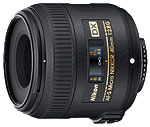 Nikon 40mm f/2.8G AF-S Micro!
Nikon 40mm f/2.8G AF-S Micro!
In July 2011, Nikon announced a new macro lens for its consumer lineup, the Nikkor 40mm f/2.8G AF-S Micro. Small and economically priced, Nikon's press literature indicates it's targeted to DX users looking to get into macro photography, as it offers a 60mm equivalent field of view for those camera users. Does it fit the bill? Find out by reading our full review of the Nikon 40mm f/2.8G AF-S Micro.
Software Review:  DxO FilmPack 3!
DxO FilmPack 3!
DxO worked on an update to its FilmPack emulsion emulator while updating Optics Pro to v6.6 but the new FilmPack 3 stands on its own. Adding support for Lightroom and Aperture, FilmPack 3 includes a few new tools as well, including: Customized film effects, Hue/Saturation/Lightness sliders, a Channel Mixer, Creative Vignetting and a Noise Removal tool. Not to mention 10 more emulsion renderings and a number of revised ones, too. Read our DxO FilmPack 3 review to see how well it does.
September 1
Hands-on Preview posted for Samsung NX200!
Samsung Electronics Co. Ltd. has today unveiled its latest flagship compact system camera, the Samsung NX200, and we've just posted our Hands-on Preview. The NX200 is based around a new APS-C sized CMOS image sensor with a resolution of 20.3 megapixels, developed by Samsung, and offering sensitivity to a maximum of ISO 12,800 equivalent. The Samsung NX200's sensor offers swift seven frames-per-second burst shooting at full resolution, and can capture bursts at a whopping 30 fps if resolution is dropped to five megapixels. The Samsung NX200 body--which has been completely restyled, and now has a more aggressive, yet still artistic look--offers not only still image shooting, but also the ability to record Full HD movie clips, using H.264 compression, and with audio from a stereo microphone. Images and movies are framed and reviewed on a 3.0-inch AMOLED display with VGA resolution, and stored on SD, SDHC, or SDXC cards. Click here to read our Samsung NX200 Hands-on Preview for more!
Review posted for Sony W570!
Among the smallest and lightest digicams we've seen this year, the Sony W570 nonetheless packs a lot of pixels. It's also comparatively light on features, which isn't necessarily a bad aspect in a small camera. It does sport a few of Sony's recent innovations, like Sweep Panorama and Dynamic Range Optimization, and some older ones, like Face and Smile detection. Buttons are small, though, and you have to take care with this little thing. How well did it perform? Click here for our review of the Sony W570.
August 26
Printer Review: 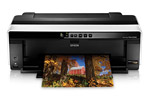 Epson R2000!
Epson R2000!
A 13x19 pigment printer that can connect three different ways and print on all sorts of media? What's not to like? At $499.99 list and as low as $279.99 directly from the company, the Epson Stylus Photo R2000, which replaces the R1900, brings more than just 13x19-inch pigment printing to the party, adding CD, roll and fine art media, UltraChrome Hi-Gloss 2 inks and WiFi/USB/Ethernet connectivity. We gave it a run for its money, printing fine art paper, CDs, 13x19 sheets and more over several weeks. We were particularly interested in how well it handled black and white printing and flesh tones with its UltraChrome Hi-Gloss 2 pigment inks. Read our review for the whole story.
August 24
Hands-on Preview posted for Sony A77 and Sony A65!
Sony Electronics Inc. has today launched two new Translucent Mirror-based cameras for its SLT-series, the Sony A77 being the long-awaited successor to the Alpha A700 DSLR, while the Sony A65 shares much of its flagship sibling's DNA at a significantly more affordable price tag. Both offer a whopping resolution of 24.3 megapixels from an Exmor APS HD CMOS image sensor, as well as class-leading burst modes, low shutter lag, full-time phase-detect AF, Full HD 1080 60p AVCHD 2.0 video, a new OLED electronic viewfinder, and a host of other features and improvements. To learn more, click here for our Sony A77 Hands-on Preview which includes a limited set of sample images and performance results from a prototype, and here for our Sony A65 Hands-on Preview.
Hands-on Preview posted for Sony NEX-7!
Just a little over 15 months after launching its NEX-series of compact system cameras, Sony Electronics Inc. today firmly declares its intent to dominate, with the launch of the Sony NEX-7. The Sony Alpha NEX-7 is impressive indeed, not only offering a whopping 24.3 megapixel sensor resolution from an Exmor APS HD CMOS image sensor, but then somehow managing to include enough power to handle shooting at up to 10 frames per second. The NEX-7's sensor also adds an electronic first-curtain exposure mechanism that allows an astoundingly short prefocus shutter lag of just 0.02 second. The NEX-7's impressive speed--enabled by a new generation BIONZ image processor--isn't limited to just still-image shooting, either. It also offers progressive-scan Full HD video at 60 frames per second, from 60fps sensor data. For an in-depth look at Sony's new flagship NEX-series compact system camera, click here to read our Sony NEX-7 Hands-on Preview.
Hands-on Preview posted for Sony NEX-5N!
Next up in a raft of interchangeable-lens camera announcements for the day, Sony Electronics Inc. has unveiled its new Sony NEX-5N compact system camera, a followup to the popular NEX-5. The Sony Alpha NEX-5N has a form-factor very similar to that of its predecessor, but take a closer look and new features abound. A new image sensor upgrades resolution just slightly to 16.1 megapixels, and adds an electronic first-curtain exposure mechanism that allows an astoundingly short prefocus shutter lag of just 0.02 second. Sensitivity ranges from a minimum of ISO 100 equivalent to a new high of ISO 25,600 equivalent. The NEX-5N's new sensor is coupled to a new generation BIONZ image processor that allows it to capture an impressive ten frames per second at full resolution, not to mention progressive-scan Full HD video at 60 frames per second, from 60fps sensor data. Click here to read our Sony NEX-5N Hands-on Preview, complete with sample images and performance results.
Lens Review: 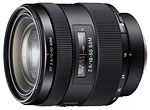 Sony 16-50mm f/2.8 DT!
Sony 16-50mm f/2.8 DT!
Even though the lens was just released today, we've had a copy of the Sony 16-50mm f/2.8 DT under guard in the SLRgear.com test lab. We had a chance to put it through its paces in the lab, and are pleased to share our full review with you. Click here to read our full review on the Sony DT 16-50mm f/2.8 SSM lens.
August 18
Review posted for Panasonic GF3!
Hailing from a camera line aimed squarely at enthusiasts, the Panasonic GF3 seems to be angling for consumers, a move that may alienate enthusiast fans. Its 12-megapixel sensor, 3-inch LCD, and touchscreen controls all fit into digicam-size space, yet it first ships with a non-zooming 14mm kit lens, so most consumers will want to wait for the zoom to ship later this month. Its pop-up flash takes the space where a hot shoe would live, and modes are changed via the touchscreen, rather than a physical dial. We found the Panasonic GF3 fun to use and a competent, comfortable companion whether moving about town or packing for a trip. Click here for more on the Panasonic GF3 digital camera!
August 15
Lens Review: 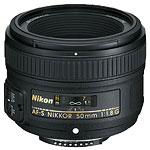 Nikon AF-S 50mm f/1.8G!
Nikon AF-S 50mm f/1.8G!
Today's lens review on SLRgear.com is the new Nikkor AF-S 50mm f/1.8G. Nikon's new take on the "nifty fifty" is a departure from the existing 50mm f/1.8D, bearing the high quality design notes of the new 50mm f/1.4G. With its weather-sealed mount gasket, windowed distance scale and circular lens hood, you might have a hard time telling them apart. We've put this lens through its paces in our test lab: Click here to read our full review of this lens.
August 11
Full Review posted for Canon T3i!
Truly easy to recommend, the versatile Canon T3i sets the standard at the top of the consumer digital SLR market. Especially if you're looking for a reasonably affordable SLR that lets you shoot from multiple angles, the Rebel T3i should be at or near the top of your list. With an 18-megapixel sensor, a high-res articulating LCD, an improved grip, and Full HD video recording, the Canon T3i has what it takes to get great shots in most conditions. Its bundled 18-55mm kit lens is improved over its predecessor, and the alternate 18-135mm kit lens is also good quality, covering a near-ideal range for most situations. Image quality is good enough for 20x30-inch prints from ISO 100 to 3,200, and ISO 12,800 shots make a good 8x10. It's quite a camera, to be sure. Click here for more on the Canon T3i!
August 4
Review posted for Canon 500 HS!
When you think of quality pocket digital cameras, the Canon S95 and G12 are top of the list. But don't ignore the Canon 500 HS, an ELPH with a wider lens than either of those cameras, and a noticeably more pocketable shape. Its major unique feature is its touchscreen, which dominates the back of the camera, much like the screen of a smartphone. Its Full HD video capture, Handheld NightScene, and High Speed Burst modes number among the standout features, but enthusiasts will be drawn to the Canon 500's Aperture and Shutter priority modes, which offer a little more control than the average point and shoot. Click here for more on the Canon PowerShot 500 HS!
August 2
Lens Review:  Olympus 75-300mm f/4.8-6.7 M.Zuiko Digital!
Olympus 75-300mm f/4.8-6.7 M.Zuiko Digital!
Near the end of 2010, Olympus released a new zoom lens for its micro four-thirds cameras, the Olympus 75-300mm f/4.8-6.7 M.Zuiko Digital. Combined with the four-thirds 2x crop factor, the lens provides an equivalent of 600mm when fully zoomed in. Do good things continue to come in small packages? We've put then lens through its paces in our test lab: Click here to read our full review of the Olympus 75-300mm f/4.8-6.7 M.Zuiko Digital.
July 29
Review posted for Sony HX7V!
While it's not the longest pocket long zoom, the Sony HX7V nevertheless has most of Sony's latest digital features, including High Resolution iSweep Panorama, Background Defocus, and Handheld Twilight mode. Its 10x zoom lens ranges from 25-250mm equivalents, and its 16.2-megapixel sensor CMOS sensor is back-illuminated for better performance in low light. As if that's not enough for the traveling shooter, the Sony Cyber-shot HX7V includes a GPS to help you track where you've been. Click here for more on the Sony HX7V digital camera!
July 26
Review posted for Sony TX10!
Waterproof, shockproof, dustproof and freezeproof, the Sony TX10 is a slick little digital camera with plenty of style. Its 16.2-megapixel sensor is designed for better performance in low light, and the Sony TX10 has many of Sony's hottest innovations, including iSweep Panorama and Underwater iSweep Panorama, among others. Full HD video is also available on this tiny camera, with stereo recording. What gave us pause, however, was our trouble with the touchscreen, which is not good when that's the camera's main interface. Click here for more on the Sony Cyber-shot TX10!
Lens Review: 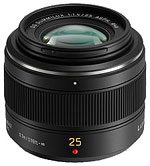 Panasonic 25mm f/1.4 ASPH Leica DG Summilux!
Panasonic 25mm f/1.4 ASPH Leica DG Summilux!
The Panasonic 25mm f/1.4 ASPH Leica DG Summilux will be hitting store shelves shortly, offering a 50mm-equivalent lens experience for micro four-thirds users, complete with a fast aperture of f/1.4. The lens doesn't come without a price tag, however: click here to read our full review.
July 18
Review posted for Nikon S9100!
Though it differs from the rest of the long zoom pack with its lack of a GPS, the Nikon S9100 more than makes up for it with its impressive 18x zoom, a razor-sharp 921K LCD screen, and a rack of continuous modes that goes great with its fast autofocus. Full HD video with stereo sound rounds out an impressive package. Click here for more on the Nikon Coolpix S9100.
July 15
Review posted for Sony HX9V!
Though there are more and more pocket long zooms to choose from, the Sony HX9V does its best to leapfrog its competition by packing even more features behind that impressive 16x, 24-384mm, image-stabilized zoom lens. Its 16.2-megapixel BSI CMOS sensor is capable of capturing high-resolution stills and Full HD video, as well as other cool Sony tricks like Sweep Panorama and Handheld Twilight mode. The Sony HX9V is also fitted with a GPS radio for easy tracking of where you've been. And you can see it all on the HX9V's 921,000-dot, 3-inch LCD screen. Click here for our Sony HX9V review!
Lens Review: 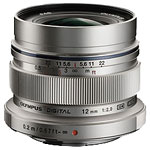 Olympus 12mm f/2 ED M.Zuiko Digital!
Olympus 12mm f/2 ED M.Zuiko Digital!
Olympus released some new lenses with the PEN E-P3, one of which is the subject of today's lens review - the Olympus 12mm f/2 ED M.Zuiko. This fast wide-angle lens offers all-metal construction and a unique two-stage manual focusing system. We've put the lens through its paces in our test lab: click here for our full review.
July 14
Full Review posted for Nikon D5100!
Back in 2009, we reviewed Nikon's D5000, the company's first SLR to include an articulated LCD display, and while we loved its image quality and feature set, the bottom-mounted tilt/swivel mechanism seemed like something of a missed opportunity. The followup Nikon D5100 switches to a more versatile side-mounted mechanism useful not only for framing high or low shots, but also for self-portraits--something of an important use case for a consumer camera. Nikon has also updated the D5100's imaging pipeline, which is now based around the same 16.2 megapixel image sensor and processing algorithms used in the popular D7000 prosumer SLR, bringing similar image quality to a much more affordable camera. The D5100 also brings in-camera HDR imaging to a Nikon SLR for the first time, and expands upon Nikon's selection of in-camera filter effects. Of these, perhaps the most interesting is a Night Vision mode that allows sensitivity to a maximum of ISO 102,400 equivalent, so long as you're willing to forgo shooting in color. Otherwise, the D5100 provides ISO sensitivities to 25,600 equivalent. Other notable features include a maximum shutter speed of 1/4,000 second, a rated shutter life of 100,000 cycles, Nikon's 3D Color Matrix Metering and 11-point Multi-CAM 1000 autofocus sensors, and Full HD (1,080p) movie capture capability. For more on this interesting digital SLR, read our Nikon D5100 review.
First test shots posted for Panasonic GF3!
We've just posted our first set of lab test shots from a production-level Panasonic GF3, straight from the lab!
The Lumix GF3 reduces body size a little further beyond that of its GF2 predecessor, and like that camera, again ranks as the smallest interchangeable lens camera with a built-in flash, according to the company. There's also been a worthwhile reduction in body-only weight. These changes do come at the cost of some features absent in the new design, though. Notably, the Panasonic GF3 lacks the earlier camera's hot shoe, as well as its accessory port, changes that mean it can't offer either external flash or an electronic viewfinder. In the absence of a hot shoe, the built-in popup flash strobe has now been rehoused directly over the central axis of the lens, a change that should make for more comfortable hand-holding. One other notable removed feature is the GF2's stereo microphone, replaced with a monaural mic. Overall, the GF3's body is much softer and more modern looking than that of its predecessor. At the rear, the most significant control change is that the e-dial has been replaced with a wheel-style dial that encircles the four-way controller. The GF2's large touch panel LCD display has been retained, and now provides the only way to frame or review images. For more details, read our hands-on Panasonic GF3 preview, and visit the Panasonic GF3 Samples page for the images we've shot so far, including links to select RAW files. Stay tuned for more sample images in the days to come!
July 13
Review posted for Fuji X100!
Few cameras in recent memory have captured the imagination of enthusiast photographers as much as the Fuji X100. Eliciting strong reactions from fans as well as detractors, the X100 is one of the hottest topics in forums and blogs. It's a unique camera in many ways. Its large APS-C sensor is married to a fixed-focal-length 23mm lens, equivalent to a 35mm lens. Its optical viewfinder can morph into an electronic viewfinder, and becomes even more rich when in Hybrid Viewfinder mode, floating a color LCD overlay in front of the optical view in true sci-fi fashion. The combination has huge potential. But of course there are some quirks, and a couple of pitfalls. The question is, does the image quality rise above it all? Click here for our review of the Fujifilm X100 to find out.
July 7
Full Review posted for Pentax K-r!
When we reviewed Pentax's K-x consumer SLR last year, we were wowed by its feature set and noise performance, but questioned several design choices likely made in the interests of an affordable price tag. The company listened, and answered our biggest criticisms in the followup Pentax K-r. Key changes include new autofocus point indicators in the viewfinder, and a redesigned, retro-styled body with a larger, significantly higher resolution display. Burst performance is now almost six frames per second, retaining the title of fastest entry-level digital SLR. There's also a new dual power-source design that accepts either a proprietary lithium-ion pack, or--via an in-body adapter-- a set of AA batteries. While numerous more subtle changes abound, the 12.4 megapixel K-r is largely similar to its predecessor, with in-body image stabilization, an 11-point autofocus system, 1/6,000 second top shutter speed, and high-definition 720p video capture. Creative features such as in-camera HDR, a cross-processing function, numerous pre- and post-capture digital filters, and in-camera raw processing make the Pentax K-r particularly well-suited to right-brain types. The Pentax K-r would've been a sure thing, but for an increase in pricing by almost a quarter, compared to that of the K-x. Having specifically called for many of the changes, we went into our review of the Pentax K-r with a feeling of having made a rod for our own back. To find out if we stayed resolute in our desire for the changes--added cost notwithstanding--read our full review of Pentax's latest consumer SLR.
July 2
Software Review:  DxO Optics Pro v6.6!
DxO Optics Pro v6.6!
DxO Optics Pro is unique in applying the company's own sensor and lens data to automatically optimize an image. You start at the finish line. The latest version brings some of that power to JPEGs from gear the company hasn't tested. We look at six case studies to see what Optics Pro can do for your Raw images (with its new Raw processing engine) and your JPEGs, whether your gear is in their database or not. Read the review to see how it fares.
July 1
Lens Review: 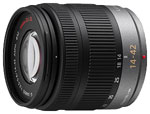 Panasonic LUMIX G 14-42mm f/3.5-5.6 OIS!
Panasonic LUMIX G 14-42mm f/3.5-5.6 OIS!
When Panasonic introduced its G2 Lumix camera body, they also updated the kit lens for the system - the Panasonic 14-42mm f/3.5-5.6 ASPH MEGA O.I.S. LUMIX G Vario. Replacing the 14-45mm, the new lens is slightly lighter and simpler to use, while incorporating Panasonic's continuously variable aperture technology for use in movie recording. We didn't have a chance to test the lens with the Panasonic G2, but we did manage to get it into the lab with the G3; click here to read our review of the Panasonic 14-42mm f/3.5-5.6 ASPH MEGA O.I.S. LUMIX G Vario lens.